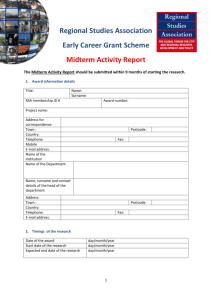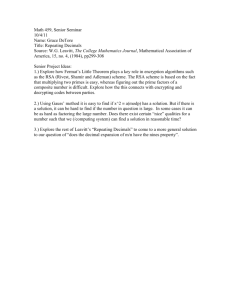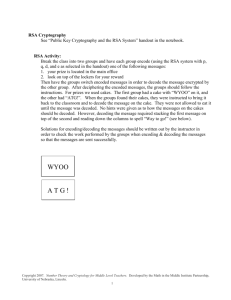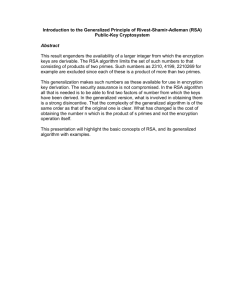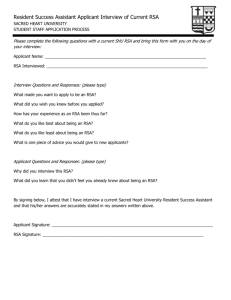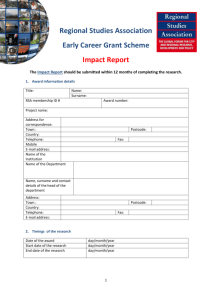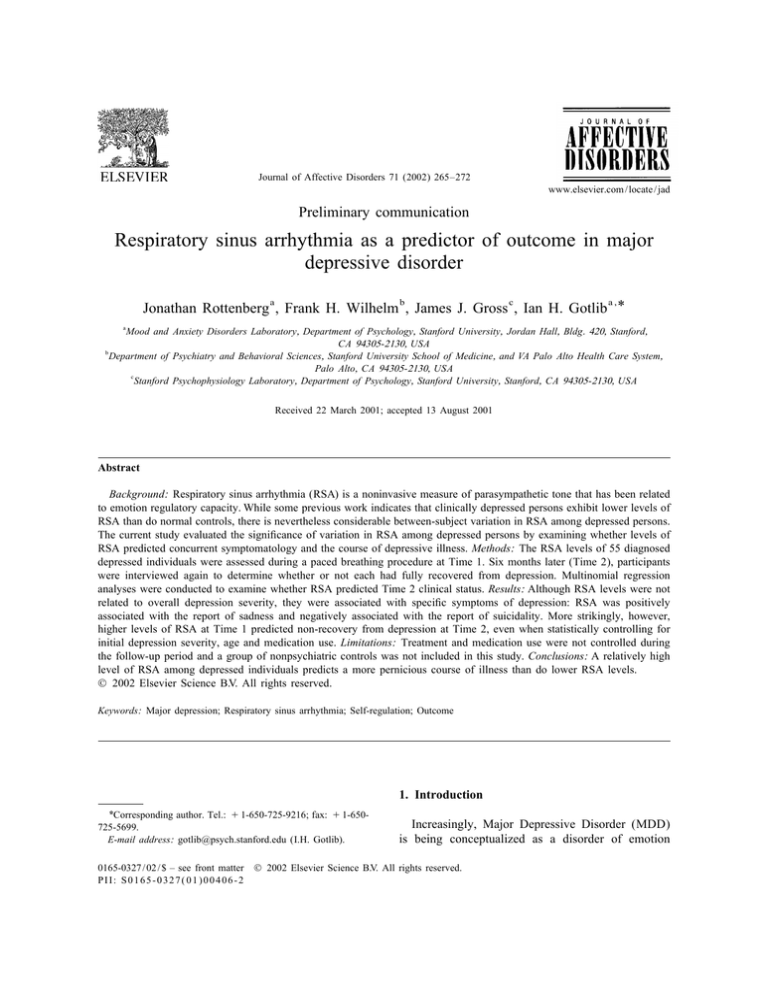
Journal of Affective Disorders 71 (2002) 265–272
www.elsevier.com / locate / jad
Preliminary communication
Respiratory sinus arrhythmia as a predictor of outcome in major
depressive disorder
a
b
c
a,
Jonathan Rottenberg , Frank H. Wilhelm , James J. Gross , Ian H. Gotlib *
a
Mood and Anxiety Disorders Laboratory, Department of Psychology, Stanford University, Jordan Hall, Bldg. 420, Stanford,
CA 94305 -2130, USA
b
Department of Psychiatry and Behavioral Sciences, Stanford University School of Medicine, and VA Palo Alto Health Care System,
Palo Alto, CA 94305 -2130, USA
c
Stanford Psychophysiology Laboratory, Department of Psychology, Stanford University, Stanford, CA 94305 -2130, USA
Received 22 March 2001; accepted 13 August 2001
Abstract
Background: Respiratory sinus arrhythmia (RSA) is a noninvasive measure of parasympathetic tone that has been related
to emotion regulatory capacity. While some previous work indicates that clinically depressed persons exhibit lower levels of
RSA than do normal controls, there is nevertheless considerable between-subject variation in RSA among depressed persons.
The current study evaluated the significance of variation in RSA among depressed persons by examining whether levels of
RSA predicted concurrent symptomatology and the course of depressive illness. Methods: The RSA levels of 55 diagnosed
depressed individuals were assessed during a paced breathing procedure at Time 1. Six months later (Time 2), participants
were interviewed again to determine whether or not each had fully recovered from depression. Multinomial regression
analyses were conducted to examine whether RSA predicted Time 2 clinical status. Results: Although RSA levels were not
related to overall depression severity, they were associated with specific symptoms of depression: RSA was positively
associated with the report of sadness and negatively associated with the report of suicidality. More strikingly, however,
higher levels of RSA at Time 1 predicted non-recovery from depression at Time 2, even when statistically controlling for
initial depression severity, age and medication use. Limitations: Treatment and medication use were not controlled during
the follow-up period and a group of nonpsychiatric controls was not included in this study. Conclusions: A relatively high
level of RSA among depressed individuals predicts a more pernicious course of illness than do lower RSA levels.
2002 Elsevier Science B.V. All rights reserved.
Keywords: Major depression; Respiratory sinus arrhythmia; Self-regulation; Outcome
1. Introduction
*Corresponding author. Tel.: 1 1-650-725-9216; fax: 1 1-650725-5699.
E-mail address: gotlib@psych.stanford.edu (I.H. Gotlib).
Increasingly, Major Depressive Disorder (MDD)
is being conceptualized as a disorder of emotion
0165-0327 / 02 / $ – see front matter 2002 Elsevier Science B.V. All rights reserved.
PII: S0165-0327( 01 )00406-2
266
J. Rottenberg et al. / Journal of Affective Disorders 71 (2002) 265 – 272
˜
regulation (Barlow, 1988; Gross and Munoz,
1995).
One physiological parameter that has been linked to
emotion regulation is respiratory sinus arrhythmia
(RSA; e.g. Porges, 1995). RSA, the rhythmic oscillation in heart period accompanying breathing, is a
non-invasive measure of cardiac vagal control
(Berntson et al., 1997). RSA is a result of the phasic
changes in vagal nerve activity at the cardiac sino–
atrial node that are linked to breathing frequency.
Vagal control of the heart reflects the basal (tonic)
firing rate of the cardiac vagal motor neuron projections from the nucleus ambiguous, which are influenced by several central projections, for example
from the amygdala and hypothalamus. This tonic
vagal firing is modulated by a respiratory-related
phasic signal from the brainstem respiratory generator. Whereas the heart period decrease is associated
with phases of inspiration when respiratory mechanisms in the brainstem attenuate the vagal efferent
action on the heart, the heart period increase is
associated with phases of expiration when the vagal
efferent influence to the heart is reinstated. The
amplitude of this heart period oscillation reflects the
level of cardiac vagal control and thus allows its
non-invasive assessment (Taylor et al., 1999). Measures of RSA extract only the relatively fast components of heart-period variability that are associated
with the respiratory frequency and not the slower
variability components that are assumed to be mediated vagally and sympathetically (Saul et al.,
1991).
Decreased levels of RSA have been linked to
self-regulatory difficulties in samples of both children (e.g. Pine et al., 1998) and adults (e.g. Thayer et
al., 1996). Interestingly, despite the clear emotion
regulatory difficulties that characterize individuals
who are diagnosed with depression, cross-sectional
studies examining levels of RSA in depressed individuals have yielded equivocal results. For example, whereas several investigators have found depressed patients to have lower RSA than do nondepressed controls (e.g. Carney et al., 1995; Dalack and
Roose, 1990; Rechlin et al., 1994), other researchers
have found depressed and nondepressed participants
to be indistinguishable with respect to their baseline
levels of RSA (e.g. Carney et al., 1988; Jacobsen et
al., 1984; Lehofer et al., 1997; Moser et al., 1998)
There have been fewer longitudinal studies ex-
amining the association between RSA and depression, but they, too, have yielded inconsistent findings. For example, Balogh et al. (1993) recorded
heart rate before and after a therapeutic trial of
antidepressant medications in 17 adult patients diagnosed with MDD. Balogh et al. examined whether
pretreatment heart-rate variability (HRV), measured
by successive mean squared differences in R–R
interval, was associated with treatment outcome and
whether HRV changed over time in concert with
changes in severity of depression. Their results
indicated that although pretreatment HRV levels did
not predict treatment response, improvement in
depressive symptoms was associated with increases
in HRV. In contrast, Schultz et al. (1997) found
exactly the opposite pattern of results: improvement
in depressive symptoms in response to a course of
electroconvulsive therapy was associated with decreases in high-frequency heart rate variability. Finally, Khaykin et al. (1998) found no relation
between treatment response and changes in highfrequency HRV.
One reason for the inconsistent findings of these
studies involves the likely heterogeneity of individuals diagnosed with depression (see Gotlib and
Hammen, 1992; in press). Indeed, some investigators
have suggested that depressed persons are heterogeneous specifically with respect to RSA (Moser et al.,
1998), an inference that has been applied to other
measures of physiological functioning in depression
(e.g. Noble and Lader, 1972). Another reason for the
discrepant findings involves limitations of these
investigations. For example, most of these studies
had relatively small sample sizes. Moreover, the
longitudinal investigations studied outcome over a
short follow-up period and had either no criteria or
very liberal criteria for defining recovery. Finally,
quantification of RSA in these studies was based
solely on heart-period measurement. Importantly,
several lines of evidence now indicate that respiratory rate and depth are significant confounds in the
assessment of cardiac vagal control. Independent of
changes in cardiac vagal control, rapid low tidal
volume breathing will reduce RSA levels, while slow
high tidal volume breathing will increase RSA levels
(e.g. Grossman and Kollai, 1993; Saul et al., 1989).
The present study was designed to address these
limitations in examining whether levels of RSA
J. Rottenberg et al. / Journal of Affective Disorders 71 (2002) 265 – 272
assessed in diagnosed clinically depressed individuals are related to (a) concurrent clinical characteristics such as depression severity; and (b) clinical
course of depression, as assessed 6 months later by a
structured clinical interview. We enrolled a large
sample of depressed individuals into the study at
Time 1 and used an assessment procedure and
mathematical quantification of RSA that was not
confounded by respiratory rate or depth. We followed
this sample for 6 months (Time 2) and then used
strict interview-based diagnostic criteria to divide the
sample into recovered and non-recovered depressives. Based on the literature in which RSA is
associated with self-regulatory capacity and psychological health, we hypothesized that higher levels of
RSA at Time 1 would be associated concurrently
with less severe depression and would predict recovery from depression at Time 2.
2. Methods
2.1. Participants
Participants were 55 unipolar depressed persons
(73% female) who were fluent in English and were
between 18 and 60 years of age. Approximately half
of the depressed participants were recruited from two
outpatient psychiatry clinics in a university teaching
hospital and half were self-referred from the community. Clinical participants had no reported lifetime
history of brain injury or primary psychotic ideation
and showed no behavioral indications of possible
impaired mental status or mental retardation. Potential participants were also excluded from the
sample if they were alcohol or substance dependent
or if they showed signs of substance or alcohol abuse
within the past 6 months. Twenty-five of the depressed participants were receiving pharmacotherapy
(ten individuals were taking SSRIs, two were taking
tricyclics, fourteen were taking other antidepressants,
such as venlafaxine and thirteen individuals were
taking other types of psychotropic medications, such
as benzodiazepines, hypnotics, or anticonvulsants).
All participants were paid $25 per hour and provided
written informed consent prior to the experimental
session.
267
2.2. Clinical assessments
All depressed subjects met DSM-IV (American
Psychiatric Association, 1994) criteria for MDD
using the Structured Clinical Interview for DSM
(SCID-I; First et al., 1995). SCID-I interviewers had
previous experience with administering structured
clinical interviews and were trained specifically to
administer the SCID-I interview prior to beginning
work on this study. An independent trained rater who
was blind to group membership evaluated 15 randomly selected audiotapes of SCID interviews with
depressed and nondepressed participants and with
non-participants who met diagnostic criteria for
disorders other than depression (e.g. panic disorder)
and for each determined whether the participant met
DSM-IV diagnostic criteria for MDD. In all 15 cases,
ratings matched the diagnosis made by the original
interviewer, k 5 1.00.
Participants also completed the Beck Depression
Inventory (BDI; Beck et al., 1979). The 21 items on
the BDI assess cognitive, affective, behavioral and
physiological symptoms of depression, with the total
score representing a combination of the number of
symptom categories endorsed and the severity of the
particular symptoms.
Six months following entry to the study (i.e. Time
2), a modified version of the SCID-I was administered to the participants. We used guidelines recommended by the NIMH Collaborative Program on
the Psychobiology of Depression (e.g. Keller et al.,
1992) to define recovery from depression. Depressed
participants were considered to be recovered if they
reported that essentially no signs of depressive
illness were present in each of the past 8 weeks (e.g.
no more than two symptoms experienced to more
than a mild degree). We adopted this stringent
definition of recovery because of the significant
functional impairment associated with residual depressive symptoms (Judd et al., 1996). Therefore,
participants who exhibited subsyndromal or
syndromal depression were considered to be nonrecovered.
2.3. Physiological assessment
An SA Instruments 12-channel bioamplifier was
used to record physiological responses. Signals were
268
J. Rottenberg et al. / Journal of Affective Disorders 71 (2002) 265 – 272
sampled at 400 Hz. Data were acquired using a
Pentium PC that used a data translation 3001 PCI
12-bit 16-channel analog to digital converter. Data
were reduced off-line using custom laboratory software. During the psychophysiology assessment, instructions were presented on a 20 in. television
monitor at a viewing distance of 1.75 m.
Participants were greeted and were seated in a
comfortable chair in a quiet, well-furnished laboratory room. Following an orientation period and the
attachment of physiological sensors, participants
were instructed to listen to a soft tone and to breathe
in when they heard the tone rising, to breathe out
when they heard the tone falling and to pause
between breaths when there was no tone. The paced
breathing trial was initiated when participants indicated that they understood these instructions. The
tonal pattern was modulated to induce a respiratory
frequency of 9 cycles / min with a normal fractional
inspiratory ratio of 40% and was presented for 2
min. The paced breathing procedure was recommended to keep respiratory rate constant both within
and between individuals during RSA assessment
(Wilhelm et al., 1998) because changes in respiratory rate can potentially confound the relationship
between cardiac vagal control and RSA. Finally,
after participating in several tasks not reported here,
participants were disconnected from monitoring devices, were paid and were reminded that they would
be contacted for a follow-up interview in 6 months
time.
An electrocardiogram was recorded using Beckman miniature electrodes, placed in a bipolar configuration on opposite sides of the participant’s chest.
In addition, two channels of respiration were measured with inductive plethysmography bands (Ambulatory Monitoring, Ardsley, NY, USA) that were
placed around the chest and abdomen. Respiration
was calibrated against fixed volume bags by the
least-squares method.
2.4. Computation of RSA
A customized computer program written in MAT(Wilhelm et al., 1999) was used to compute
RSA. Raw signals of the two respiratory bands were
converted to lung volume change using regression
weights derived from calibrations and resampled to 4
LAB
Hz. The heart period (HP) was calculated from the
ECG as the interval (in ms) between successive R
waves (R–R interval). The R–R intervals were
edited for outliers due to artifacts or ectopic myocardial activity, linearly interpolated and converted into
instantaneous time series with a resolution of 4 Hz.
To adjust for the confounding effects of variations
in tidal volume in the assessment of cardiac vagal
control from heart period oscillations, transfer function analysis was employed for the paced breathing
data of each study participant. The level of transfer
function respiratory sinus arrythmia (RSA TF ) was
estimated as the magnitude of the transfer function
relating heart period oscillations to lung volume
oscillations at the peak respiratory frequency. This
frequency was identified as the greatest local maximum in the 0.15–0.50 Hz lung volume power
spectral density function. RSA TF was thus adjusted
for the confounding effect of within- and betweensubject variation in respiratory depth.
RSA TF was derived from the data using spectral
analysis according to the following procedure: HP
and lung volume (LV) time series were first linearly
detrended and the power spectral densities (PHP and
PLV ) are derived for each period using the Welch
algorithm (Welch, 1967), which ensemble averages
successive periodograms. Averages were derived
from spectra estimated for 60-s data segments,
overlapping by half. For each 60-s segment, 256
points were analyzed, which includes 240 sampled
points with zero padding. The segments were Hanning windowed and subjected to Fast Fourier transform. Estimates of power were adjusted to account
for attenuation produced by the Hanning window.
The products of the segments of PLV and PHP were
averaged to form PLV,HP , the cross spectral density of
PLV and PHP . The transfer function T LV, HP was
computed as the quotient of PLV,HP and PLV . RSA TF
was the value of T LV, HP at the respiratory frequency.
The respiratory frequency was identified as the
greatest local maximum in the 0.13–0.50 Hz lung
volume power spectral density function (and was
0.1560.01 Hz for all participants during paced
breathing). Spectral coherence at this frequency was
required to be above 0.5 (which was met for all
participants) to ensure that measured HP oscillations
were truly due to respiratory sources and not due to
non-RSA variation. The resulting value of RSA TF
J. Rottenberg et al. / Journal of Affective Disorders 71 (2002) 265 – 272
reflects the average magnitude of heart period oscillations per lung volume change in ms / ml during the
paced breathing.
For comparison, the conventional RSA measure,
high frequency power of heart period (HF-RSA),
was computed by summing PHP values over the
frequency band associated with respiration (0.13–
0.50 Hz) and resulting values were transformed using
the natural logarithm.
269
Table 2
Correlations of RSA TF and symptoms of depression
Sadness
Loss of interest
Guilt
Worthlessness
Indecisiveness
Insomnia
Fatigue
Weak appetite
Weight loss
Suicide
0.30*
2 0.11
0.09
2 0.19
0.06
2 0.03
2 0.05
2 0.07
0.04
2 0.27*
*, P , 0.05.
3. Results
Based on the SCID interviews at Time 2, 11 of the
55 depressed individuals in this study (20%) were
completely recovered from depression and 44 (80%)
were not recovered. Table 1 shows that the nonrecovered subjects were similar to the fully recovered participants with respect to self-reported depression severity at Time 1, t(53) , 1, current treatment
status, x 2 , 1, gender composition, x 2 , 1, age,
t(53) , 1 and level of education, t(53) , 1, all P
values . 0.15. In addition, recovered and non-recovered participants did not differ in their overall use
of psychotropic medications at Time 1 or in their use
of any individual subcategory of psychotropic medication (e.g. tricyclics, SSRIs.), all x 2 , 1, all P
values . 0.15.
Variability in RSA TF was not significantly related
to overall depression severity as measured by the
BDI, (r 5 2 0.16, P . 0.15). RSA TF was, however,
significantly correlated with two individual depression symptom severity scores (as measured by the
BDI): positively with sadness, r 5 0.30, P , 0.05
and negatively with suicidal impulses, r 5 2 0.27,
P , 0.05 (see Table 2). An identical pattern of
significant correlations was obtained when the analyses were repeated with the conventional measure of
RSA, high frequency power of heart period (HFRSA). Not surprisingly, the two measures of RSA
(HF-RSA and RSA TF ) were significantly correlated
with each other, r 5 0.76, P , 0.001.
A multinomial logistic regression analysis was
conducted using initial RSA TF levels to predict Time
2 depression status. The results of this analysis
indicated that RSA TF levels at Time 1 significantly
predicted diagnostic status at Time 2, x 2 5 4.90,
df 5 1, P , 0.05. In contrast, the results of a similar
analysis using Time 1 HF-RSA indicated that this
variable did not predict subsequent diagnostic status,
x 2 5 2.87, df 5 1, P . 0.05. As can be seen in Table
1, depressed individuals who did not recover by
Time 2 had higher RSA TF values at Time 1 (M 5
0.153, S.D. 5 0.098) than did depressed persons who
went on to recover fully (M 5 0.087, S.D. 5 0.065).
Because initial levels of RSA TF were associated with
medication use (depressed participants taking psychotropics had marginally lower levels of RSA TF
than did depressed participants who were not taking
medication, t(53) 5 1.83, P , 0.07) and with age
(r 5 2 0.53, P , 0.01), the logistic regression analysis was repeated using psychotropic medication use,
age and Time 1 depression severity (as assessed by
Table 1
Initial sample characteristics by subsequent diagnostic status
Group
n
Age
(years)
Female
(%)
Education
BDI
Treated
(%)
*
RSA TF
Nonrecovered
Recovered
44
11
33.4 (10.5)
32.3 (11.7)
66.3
72.7
6.5 (1.5)
6.6 (1.4)
23.6 (7.2)
22.9 (6.4)
60.9
54.5
0.153 (0.098)
0.087 (0.065)
BDI, Beck Depression Inventory score; RSA TF , transfer function respiratory sinus arrhythmia, ms / ml. Note: Numbers in parentheses are
standard deviations.
*, P , 0.05.
270
J. Rottenberg et al. / Journal of Affective Disorders 71 (2002) 265 – 272
BDI) as covariates. In this analysis, Time 1 RSA TF
levels continued to predict Time 2 depression outcome, even with these other variables included in the
model, x 2 5 8.69, df 5 1, P , 0.005.
4. Discussion
The broad aim of this study was to examine the
clinical significance of heterogeneity in RSA within
a sample of depressed individuals. To this end, we
examined the association between levels of RSA and
concurrent depressive symptomatology and the clinical course of depression over a 6-month follow-up
period. We found levels of RSA to be related to
individual symptoms of depression, but not to overall
concurrent depression severity. Perhaps more strikingly, despite our expectation that higher levels of
RSA would be associated with better outcome, our
data indicated the opposite association: higher levels
of RSA at Time 1 predicted worse clinical outcome
at Time 2, 6 months later. This unexpected finding
warrants comment.
Our hypothesis that high RSA would be associated
with recovery from depression was derived primarily
from the general RSA literature in which high RSA
has been found to be related to psychological health
in unselected samples. For example, Fabes and
Eisenberg (1997) found RSA to be associated with
the ability to cope with life stressors in a sample of
adults. From a different perspective, other investigators have found that psychological stress (e.g.
Allen and Crowell, 1989) and rumination (Thayer et
al., 1996) led to lower levels of RSA and that
psychological relaxation increases RSA levels
(Skakibara et al., 1994). Because this work was
conducted with samples of nondepressed individuals,
one obvious issue in the present context involves the
generalizability of these findings to clinically depressed individuals.
Interestingly, in previous studies the relation of
RSA to psychological health among depressed individuals has been both weak and ambiguous. We
described earlier the inconsistent findings concerning
lowered RSA in depressed individuals relative to
controls. It is also the case that several investigations
(including the present study) have failed to find the
expected inverse relation between depression severi-
ty and RSA level in samples of currently depressed
persons (e.g. Moser et al., 1998; Watkins et al.,
1999). Finally, in none of the short-term longitudinal
studies of depressed individuals was RSA found to
play a protective role with respect to predicting
improvements in depression symptoms or in other
measures of psychological health. Importantly, the
lack of previous findings indicating a protective role
for RSA for the psychological health of depressed
individuals stands in sharp contrast to the domain of
physical health, in which robust evidence exists that
decreased RSA may mediate the increased risk for
cardiac mortality and morbidity that is observed in
individuals with MDD (Musselman et al., 1998).
The data reported here represent the first evidence
that RSA may be of great clinical importance in
depression. In the present study, which examined the
largest sample of depressed participants to date and
which used spectral analytic measures to assess
cardiac vagal control, lower levels of RSA were
found to predict recovery from depression at 6
months, even when initial depression severity and a
number of other potentially confounding variables
were controlled statistically. Moreover, our measures
of RSA were psychometrically sound, exhibiting the
expected relations with age (Hellman and Stacey,
1976) and medication use (Jacobsen et al., 1984).
It is not yet clear by what mechanisms RSA might
affect the course of depression. Indeed, the correlations we obtained between RSA and different symptoms of depression suggest that the nature of the
relation between RSA and the larger construct of
depression is likely to be complex. The significant
positive association between RSA and reports of
acute sadness is intriguing because persistent sad
mood is, in many ways, the defining emotional
feature of MDD. The present finding of greater
sadness among depressed individuals with higher
levels of RSA is consistent with within-subjects
research demonstrating a relation between increases
in HRV and increases in sad mood state (Miller and
Wood, 1997). At the same time, however, RSA was
inversely related to the symptom of suicidality.
While these correlational findings should be regarded
as exploratory, these data raise the possibility that
inconsistency in the results of prior RSA studies
relates to the clustering of different depression
symptom profiles in different patient samples.
J. Rottenberg et al. / Journal of Affective Disorders 71 (2002) 265 – 272
In closing, we should point out that this was a
naturalistic study of the course of depression. RSA
predicted 6-month outcomes even though depressed
participants were heterogeneous with respect to the
medications and treatments they received during the
follow-up period. Although RSA-associated differences appear to be unrelated to the use of treatment
or medication, only random assignment to treatment
could rule this out as an explanation for our findings.
Finally, in future work assessing RSA variation
among depressed persons it would be useful to have
RSA data from nonpsychiatric controls as a reference
point. Nevertheless, we believe that our conclusion
that higher RSA leads to a more pernicious course of
illness in depression is intriguing and warrants
replication.
Acknowledgements
The authors express their appreciation to Megan
McCarthy, Sadia Najmi, Kate Reilly, and Bruce
Arnow for their help in conducting this study. This
research was supported by National Institute of
Mental Health grant MH59259 awarded to Ian H.
Gotlib and, in part, by MH56094 (FW) and
MH58147 (JG).
References
Allen, M.T., Crowell, M.D., 1989. Patterns of autonomic response
during laboratory stressors. Psychophysiology 26, 603–614.
American Psychiatric Association, 1994. Diagnostic and Statistical
Manual of Mental Disorder, 4th ed. American Psychiatric
Association, Washington, DC.
Balogh, S., Fitzpatrick, D.F., Hendricks, S.E., Paige, S.R., 1993.
Increases in heart rate variability with successful treatment in
patients with major depressive disorder. Psychopharmacol.
Bull. 29, 201–206.
Beck, A.T., Rush, A.J., Shaw, B.F., Emery, G., 1979. Cognitive
Therapy of Depression. Guilford, New York.
Barlow, D.H., 1988. Disorders of emotion. Psycholog. Inq. 2,
58–71.
Berntson, G.G., Bigger, Jr. J.T., Eckberg, D.L., Grossman, P.,
Kaufmann, P.G., Malik, M., Nagaraja, H.N., Porges, S.W., Saul,
J.P., Stone, P.H., van der Molen, M.W., 1997. Heart rate
variability: origins, methods, and interpretive caveats. Psychophysiology 34, 623–648.
Carney, R.M., Saunders, R.D., Freedland, K.E., Stein, P., Rich,
M.W., Jaffe, A.S., 1995. Association of depression with re-
271
duced heart rate variability in coronary artery disease. Am. J.
Cardiol. 76, 562–564.
Carney, R.M., Rich, M.W., teVelde, A., Saini, J., Clark, K.,
Freedland, K.E., 1988. The relationship between heart rate,
heart rate variability and depression in patients with coronary
artery disease. J. Psychosom. Res. 32, 159–164.
Dalack, G.W., Roose, S.P., 1990. Perspectives on the relationship
between cardiovascular disease and affective disorder. J. Clin.
Psychiatry 51, 4–11.
Fabes, R.A., Eisenberg, N., 1997. Regulatory control and adults’
stress-related responses to daily life events. J. Pers. Soc.
Psychol. 73, 1107–1117.
First, M.B., Gibbon, M., Spitzer, R.L., Williams, J.B.W., 1995.
User’s Guide for the Structured Clinical Interview for DSM-IV
Axis I Disorders (SCID-I, Version 2.0, October 1995, Final
Version).
Gotlib, I.H., Hammen, C.L., 1992. Psychological Aspects of
Depression: Toward A Cognitive-interpersonal Integration.
Wiley, Chichester.
Gotlib, I.H., Hammen, C.L., in press. Handbook of Depression,
Guilford: New York.
˜
Gross, J.J., Munoz,
R.F., 1995. Emotion regulation and mental
health. Clin. Psychol.: Sci. Pract. 2, 151–164.
Grossman, P., Kollai, M., 1993. Respiratory sinus arrhythmia,
cardiac vagal tone, and respiration: within- and between-individual relations. Psychophysiology 30, 486–495.
Hellman, J.B., Stacey, R.W., 1976. Variation of respiratory sinus
arrhythmia with age. J. Appl. Physiol. 41, 734–738.
Jacobsen, J., Hauksson, P., Vestergaard, P., 1984. Heart rate
variation in patients treated with antidepressants: An index of
anticholinergic effects? Psychopharmacology 84, 544–548.
Judd, L.L., Paulus, M.P., Wells, K.B., Rapaport, M.H., 1996.
Socioeconomic burden of subsyndromal depressive symptoms
and major depression in a sample of the general population.
Am. J. Psychiatry 153, 1411–1417.
Keller, M.B., Lavori, P.W., Mueller, T.I., Endicott, J., Coryell, W.,
Hirschfeld, R.M.A., Shea, T., 1992. Time to recovery,
chronicity, and levels of psychopathology in major depression:
A 5-year prospective follow-up of 431 subjects. Arch. Gen.
Psychiatry 49, 809–816.
Khaykin, Y., Dorian, P., Baker, B., Shapiro, C., Sandor, P.,
Mironov, D., Irvine, J., Newman, D., 1998. Autonomic correlates of antidepressant treatment using heart-rate variability
analysis. Can. J. Psychiatry 43, 183–186.
Lehofer, M., Moser, M., Hoehn-Saric, R., Mcleod, D., Liebmann,
P., Drnovsek, B., Egner, S., Hildebrandt, G., Zapotoczky, H.,
1997. Major depression and cardiac autonomic control. Biol.
Psychiatry 42, 914–919.
Miller, B.D., Wood, B.L., 1997. Influence of specific emotional
states on autonomic reactivity and pulmonary function in
asthmatic children. J. Am. Acad. Child Adolesc. Psychiatry 36,
669–677.
Moser, M., Lehofer, M., Hoehn-Saric, R., McLeod, D.R., Hildebrandt, G., Steinbrenner, B., Voica, M., Liebmann, P.,
Zapotoczky, H., 1998. Increased heart rate in depressed
subjects in spite of unchanged autonomic balance? J. Affect.
Disord. 48, 115–124.
272
J. Rottenberg et al. / Journal of Affective Disorders 71 (2002) 265 – 272
Musselman, D.L., Evans, D.L., Nemeroff, C.B., 1998. The relationship of depression to cardiovascular disease: epidemiology,
biology, and treatment. Arch. Gen. Psychiatry 55, 580–592.
Noble, P., Lader, M., 1972. A physiological comparison of
‘endogenous’ and ‘reactive’ depression. Br. J. Psychiatry 120,
541–542.
Pine, D.S., Wasserman, G.A., Miller, L., Coplan, J.D., Bagiella, E.,
Kovelenku, P., Myers, M.M., Sloan, R.P., 1998. Heart period
variability and psychopathology in urban boys at risk for
delinquency. Psychophysiology 35, 521–529.
Porges, S.W., 1995. Cardiac vagal tone: A physiological index of
stress. Neurosci. Biobehav. Rev. 19, 225–233.
Rechlin, T., Weis, M., Spitzer, A., Kaschka, W.P., 1994. Are
affective disorders associated with alterations of heart rate
variability? J. Affect. Disord. 32, 271–275.
Saul, J.P., Berger, R.D., Albrecht, P., Stein, S.P., Chen, M.H.,
Cohen, R.J., 1991. Transfer function analysis of the circulation:
unique insights into cardiovascular regulation. Am. J. Physiol.
261, 1231–1245.
Saul, J.P., Berger, R.D., Chen, M.H., Cohen, R.J., 1989. Transfer
function analysis of autonomic regulation. II. Respiratory sinus
arrhythmia. Am. J. Physiol. 256, H153–161.
Schultz, S.K., Anderson, E.A., van de Bourne, P., 1997. Heart rate
variability before and after treatment with electroconvulsive
therapy. J. Affect. Disord. 44, 13–20.
Skakibara, M., Takeuchi, S., Hayano, J., 1994. Effect of relaxation
training on cardiac parasympathetic tone. Psychophysiology
31, 223–228.
Taylor, E.W., Jordan, D., Coote, J.H., 1999. Central control of the
cardiovascular and respiratory systems and their interactions in
vertebrates. Physiol. Rev. 79, 855–916.
Thayer, J.F., Friedman, B.H., Borkovec, T.D., 1996. Autonomic
characteristics of generalized anxiety disorder and worry. Biol.
Psychiatry 39, 255–266.
Watkins, L.L., Grossman, P., Krishnan, R., Blumenthal, J.A.,
1999. Anxiety reduces baroreflex cardiac control in older adults
with major depression. Psychosom. Med. 61, 334–340.
Welch, P.D., 1967. The use of fast Fourier transform for the
estimation of power spectra: a method based on time averaging
over short modified periodograms. IEEE Trans. Audio Electroacoust. 15, 70–73.
Wilhelm, F.H., Grossman, P., Roth, W.T., 1999. Analysis of
cardiovascular regulation. Biomed. Sci. Instrum. 35, 135–140.
Wilhelm, F.H., Berkowitz, J., Hansen, M., Grossman, P., Roth,
W.T., Gross, J.J., 1998. RSA estimation during spontaneous
breathing using a paced breathing calibration. Psychophysiology 35, S88, (Abstract).



